
We've seen all the advertisements and heard all the pitches. How these after-market programmers can add 25 horsepower instantly, increase fuel economy and make you better looking. So, we decided to pull together all of the programmers and power modules available for a nearly-new Jeep Wrangler and test the things that you're probably wondering about if you are thinking about buying one of these. Things like how much more power and can I really feel a difference? What's the effect on fuel economy? How hard are they to install? And what else can these do for me?
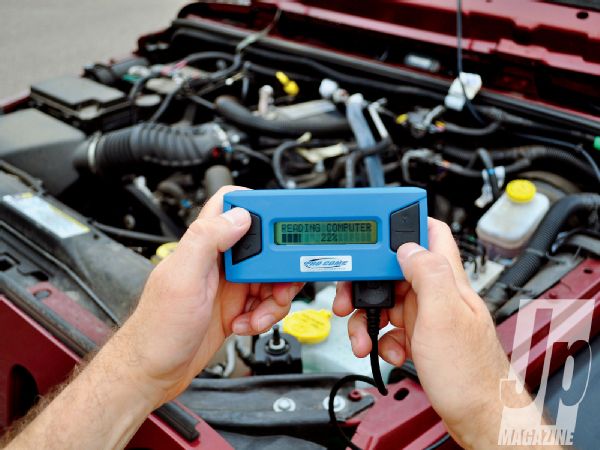
It's probably not news to you that the vehicle tuning, and therefore performance, on your late-model Jeep is completely computer-controlled. How much fuel and how much spark, at what rpm and under what load are all decisions made by a tidy and tightly-controlled chart inside your Jeep's computer. If you have JK, WK, or XK, then even your gas pedal is just a rheostat switch that provides input into your vehicle computer - no more throttle cable! So if you want to make some more power or improve your fuel economy, your solution should probably start with the click of an electrical connector.
 In addition to 0-60 mph performance testing, we logged 7,000 miles over three months and kept track of every drop of fuel to test fuel economy of the programmers and performance modules. For consistency, the miles were measured during the same daily 106-mile commute, no cargo was carried, and the AC was not used. Driving style was maintained as much as possible.
In addition to 0-60 mph performance testing, we logged 7,000 miles over three months and kept track of every drop of fuel to test fuel economy of the programmers and performance modules. For consistency, the miles were measured during the same daily 106-mile commute, no cargo was carried, and the AC was not used. Driving style was maintained as much as possible.
We started with an automatic '08 Jeep Wrangler Unlimited Rubicon that had about 7,600 miles on the clock. This means it was broken in, but not worn out. It was also completely stock. We then put 7,000 more miles on the Jeep over the next three months, logging fuel consumption, playing with features, doing acceleration runs, and generally living with the daily-driving characteristics of each programmer or module.
All of our acceleration testing was done at the same time to control variables such as temperature, miscellaneous wear and tear on the vehicle, and so on. While we included advertised power-gain numbers in the At-a-Glance chart, no one drives a dyno, so we decided to do 0-60 mph testing. This is something you do every time you get on the freeway, and most people can relate to it. You also know that a 1/2-second improvement in 0-60 is something you can feel, while a 0.05-second improvement isn't, at least not in a six-cylinder Jeep Wrangler.
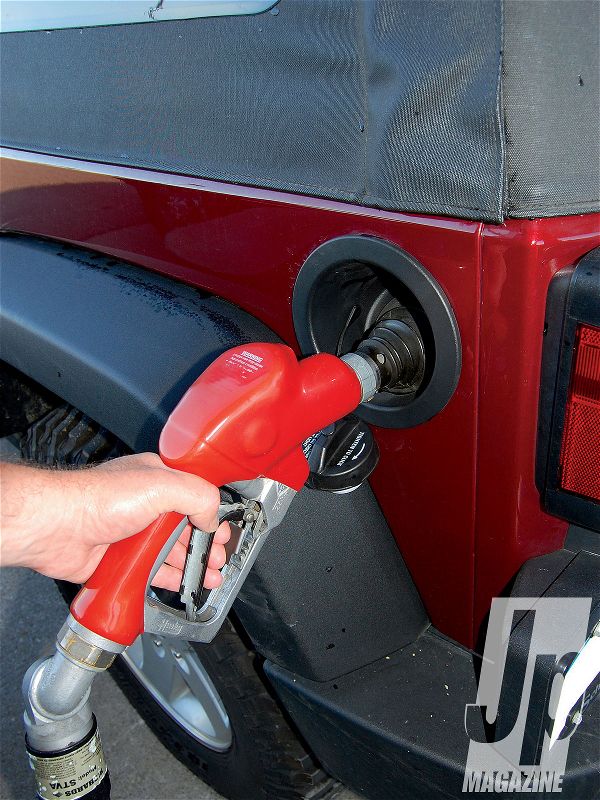 We even used the same gas station for every fill up to try to keep everything as consistent as possible. All of the performance modules and programmers delivered a performance gain, and nearly all of them delivered better fuel economy. That's having your cake and eating it too! Some of them delivered a gain in gas mileage of about 7-percent in our testing.
We even used the same gas station for every fill up to try to keep everything as consistent as possible. All of the performance modules and programmers delivered a performance gain, and nearly all of them delivered better fuel economy. That's having your cake and eating it too! Some of them delivered a gain in gas mileage of about 7-percent in our testing.
Fuel economy was logged over three months. The miles tracked were during a 106-mile daily commute. The drive was about 60 percent freeway, and the remaining miles were on surface streets. Accessory use and cargo in the Jeep were kept consistent to minimize variables in fuel consumption.
We have to admit that we were skeptical when we started the testing for this article. After all, just the premises of better performance and better fuel economy seem at odds with each other. But we were surprised that they all delivered what they promised. Exactly how much they provided varied, as did the features each one offers. Check out our At-a-Glance chart for side by side comparisons.
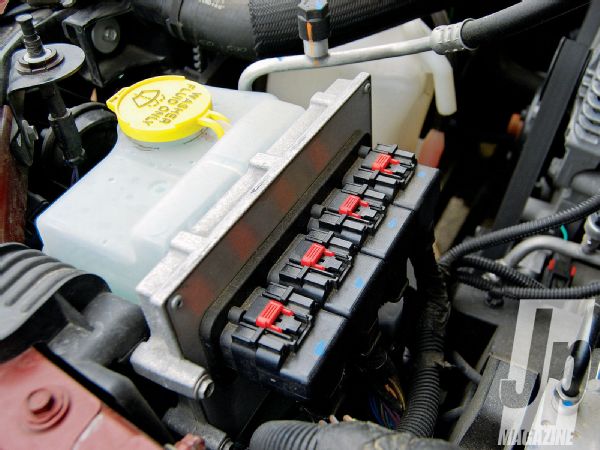 The JET Stage 1 module and Unichip Plug-n-Play Kit install underhood. This requires disconnecting the battery and removing either one (for the JET unit) or two (for the Unichip kit) of the factory wiring harness connections from the Powertrain Control Module (PCM). The PCM on a JK is located on the driver-side inner fenderwell, just behind the radiator and windshield washer reservoir.
The JET Stage 1 module and Unichip Plug-n-Play Kit install underhood. This requires disconnecting the battery and removing either one (for the JET unit) or two (for the Unichip kit) of the factory wiring harness connections from the Powertrain Control Module (PCM). The PCM on a JK is located on the driver-side inner fenderwell, just behind the radiator and windshield washer reservoir.
Meet the Players
There are two flavors of electronic tuning devices for the Jeep JK. One category is programmers. These connect to the vehicle diagnostic port and download a new calibration or tune into your factory computer. The advantage of these units is that you can program a variety of other items, such as correcting the speedometer after you change tires and gears. Some allow you to do even more, which we'll talk about later. The other category of tuning devices is an in-line computer, sometimes called a piggy-back computer. These units leave the calibration in the factory computer and adjust the engine tuning inline. The advantage of this type of system is that they leave no trace of ever being installed. While neither programmers nor in-line computers void the factory warranty, the in-line systems leaving no footprint saves you from ever having that conversation with your dealer. Both of these types of systems are easy to install and require no real mechanical knowledge.
We literally tested every programmer and power module available for the Jeep JK (or at least everyone that we're aware of): AEV, Hypertech, Pro Comp, Superchips and Unichip. Almost every one of these has some unique offering - something that makes it standout from the others.
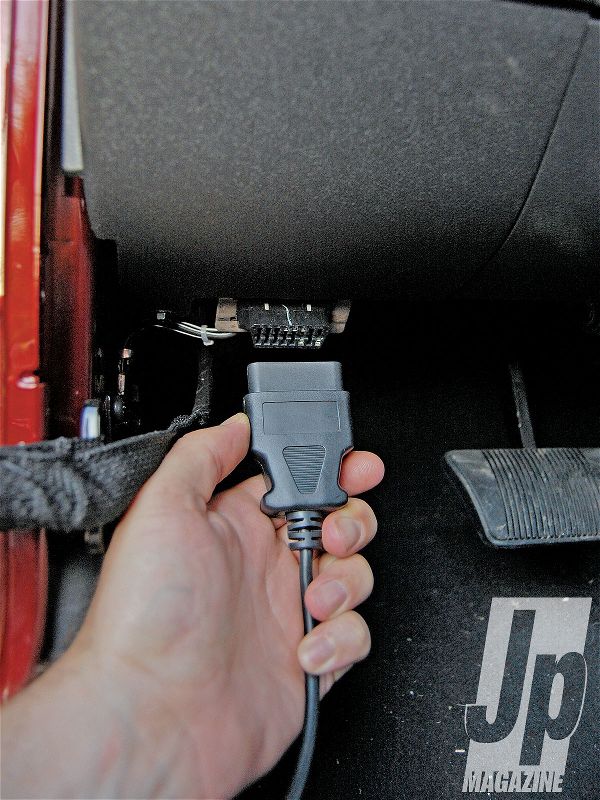 The AEV, Hypertech, Pro Comp, and Superchip programmers plug into the diagnostic port, located under the driver's side of the dashboard. These units are connected to the vehicle only during programming, not during normal driving. They all fit in the glove box so you can carry them with you in case you want to change anything on the trail, or anywhere else for that matter.
The AEV, Hypertech, Pro Comp, and Superchip programmers plug into the diagnostic port, located under the driver's side of the dashboard. These units are connected to the vehicle only during programming, not during normal driving. They all fit in the glove box so you can carry them with you in case you want to change anything on the trail, or anywhere else for that matter.
During the more than three months we spent testing these products, we found that every one of them offered performance and fuel economy gains. We didn't experience any hiccups in vehicle calibration and we had a lot of fun playing with the various features some of the programmers included. In the end, all of them offered a performance improvement that we could feel with the seat of our pants, so the right one for you will depend on exactly what features you're looking for.
AEV ProCal Module
The team at AEV didn't feel the need to mess with performance and fuel-economy calibrations, but decided to focus exclusively on control and features that are important for real off-roaders. Beyond the basics of resetting diagnostic trouble codes and recalibrating the speedometer when you add larger tires and change the axle gear ratio, there are several off-road friendly features. It can adjust the tire-pressure monitoring system so the alarm activates at a lower pressure, or turn the alert off altogether. You can also raise the idle rpm for winching, using an air compressor, or welding. One of the coolest features found only in the AEV unit is the steering-wheel centering mode.
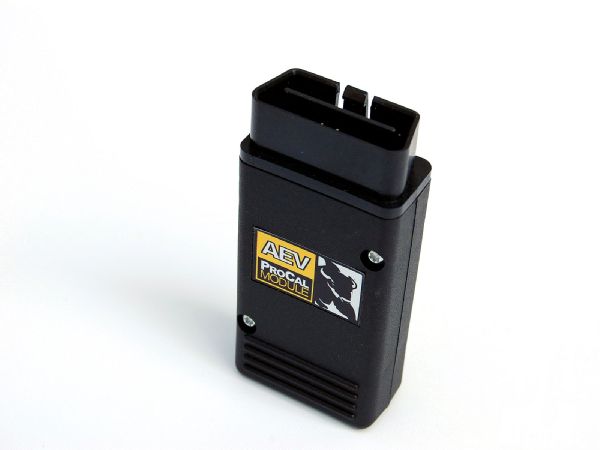
Most Electronic Stability Program (ESP) trouble after a JK is lifted is caused by the steering wheel not being centered properly, and as a result, the steering-wheel angle sensor is off. Additional features include being able to activate daytime running lights and turn off the one-touch turn signals. A key benefit of the AEV ProCal is that it costs roughly a third of most of the other modules in this article. It doesn't give you more power or fuel economy, but it's a bargain if you're only interested in the features it does offer. AEV also includes the ProCal with its Nth Degree premium suspension kits.
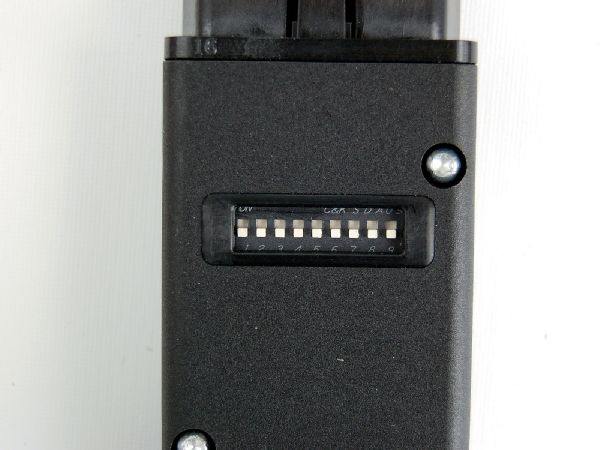 The AEV ProCal offers control over the systems that matter most to off-roaders. Like turning the tire-pressure monitoring system down or off. And, it is relatively easy to use. By moving DIP switches, there are about ten different features you can use. The ProCal is also what AEV uses to set up a new PCM when doing one of its HEMI swaps.
The AEV ProCal offers control over the systems that matter most to off-roaders. Like turning the tire-pressure monitoring system down or off. And, it is relatively easy to use. By moving DIP switches, there are about ten different features you can use. The ProCal is also what AEV uses to set up a new PCM when doing one of its HEMI swaps.
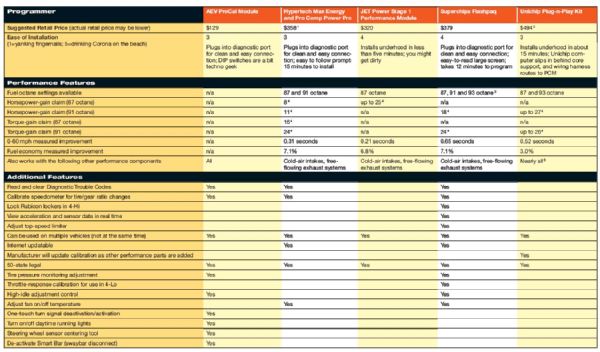
Hypertech Max Energy
Hypertech focused on performance and drivability gains over the entire engine-operating range. Not only does the Hypertech tune provide more power at wide-open throttle, it also provides significant power increases at lower rpm levels, which translates into improved drivability and a feeling of better response during normal driving. For the JK application, the factory shift points at wide-open-throttle effectively use the engine power band, so these were left stock. The firmness was increased, however. The Max Energy works well with most performance hard parts such as cold-air intake systems and free-flowing exhausts, as well as on unmodified engines.
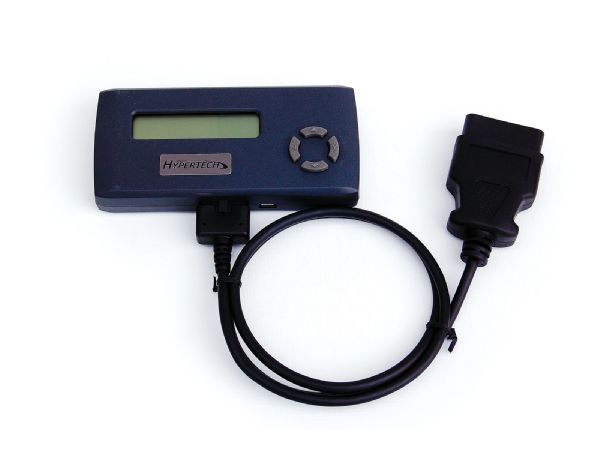
In addition to more power, the Max Energy lets you easily recalibrate the Jeep speedometer after making tire or gear ratio changes. You can also adjust the electric cooling fan on and off temperature.
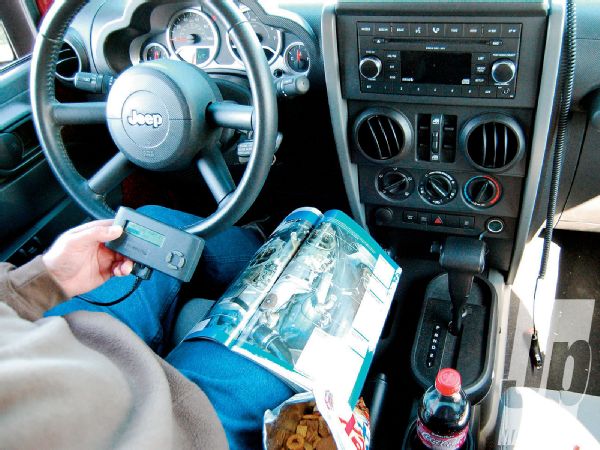 The Hypertech and Pro Comp programmers take a little more than 20 minutes to install their calibration in the PCM. Bring a magazine, some chips, and a soda; you should not leave the vehicle unattended during programming. And you can't use any of the vehicle electrical features such as the radio, or open a door that would turn on a dome light (this is true for any programmer).
The Hypertech and Pro Comp programmers take a little more than 20 minutes to install their calibration in the PCM. Bring a magazine, some chips, and a soda; you should not leave the vehicle unattended during programming. And you can't use any of the vehicle electrical features such as the radio, or open a door that would turn on a dome light (this is true for any programmer).
The Max Energy plugs into the vehicle's diagnostic port under the dashboard with a supplied cable. The prompts are easy to follow, allowing you to choose from an 87- or 93-octane performance calibration, choosing tire size and gear ratio if you've changed them from stock, and deciding whether you want to adjust the cooling fan operating temperature. Another cable is also included to connect the Max Energy to your computer for programmer updates via the Internet.
Pro Comp Power Pro
The Power Pro is a lot like the Hypertech Max Energy. In fact, the tuning and features are identical, as they are provided by Hypertech. The case is a bit different, but the power gains, improved drivability, and features are the same.
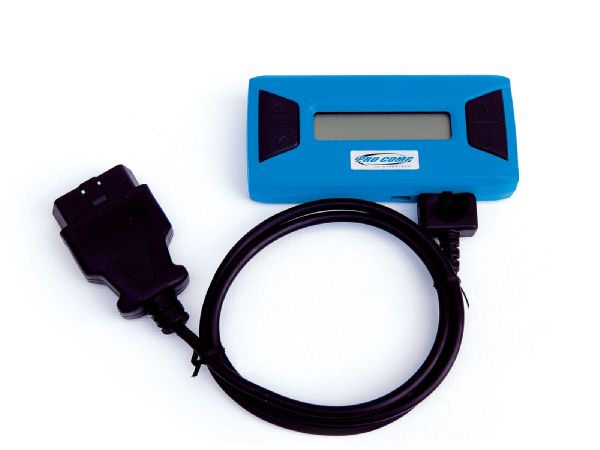
The Power Pro is a natural addition if you're purchasing larger Pro Comp tires and a suspension system, making it easy to recalibrate the speedometer and increase the power and fuel economy.
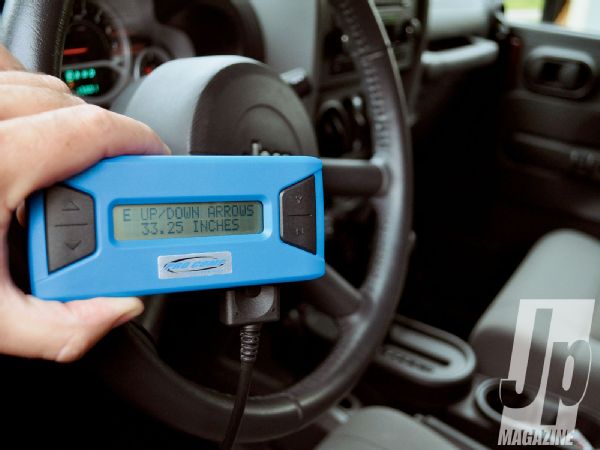 The Hypertech and Pro Comp units give you easy-to-follow directions and choices that scroll across the mini screen, such as, "Have you changed tire size?" There are Yes/No and Up/Down buttons to make selections. Both of these programmers made a difference in power that we could feel in everyday driving. They also tied the Superchips Flashpaq for best improvement in fuel economy.
The Hypertech and Pro Comp units give you easy-to-follow directions and choices that scroll across the mini screen, such as, "Have you changed tire size?" There are Yes/No and Up/Down buttons to make selections. Both of these programmers made a difference in power that we could feel in everyday driving. They also tied the Superchips Flashpaq for best improvement in fuel economy.
JET Power Stage 1 Performance Module
The folks at JET focused exclusively on power and fuel economy gains. The company offers two Performance Modules for most Jeep applications. The Stage 1 Performance Module is for a stock engine, or for very mild upgrades such as a free-flowing air filter, and it can use 87-octane fuel. The Stage 2 module has more aggressive programming and requires the use of 91-octane fuel, a 180-degree thermostat, and free-flow exhaust. Stage 2 also works well with aftermarket intake systems, mass-air sensors, and throttle-body spacers.
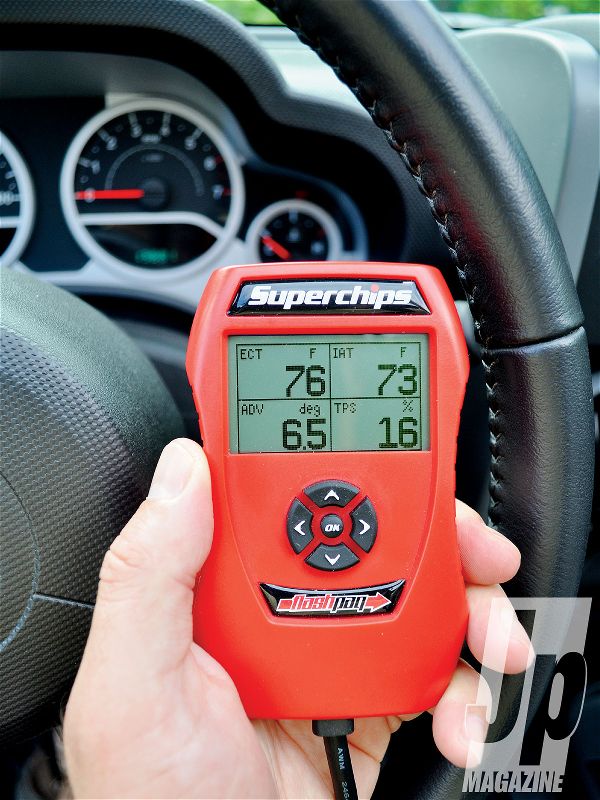
A big advantage for the JET Stage 1 Performance Module is the easy installation. It takes longer to disconnect the battery cable than it does to actually click the module between the factory wiring harness and the PCM.
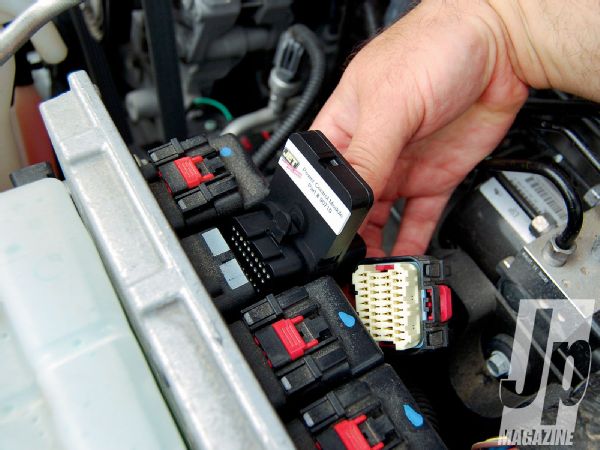 The JET Stage 1 module was by far the easiest and fastest of all the units to install. We read the directions and were being extra careful the first time, and it only took five minutes. After that it was a one minute swap. It takes longer to disconnect and reconnect the battery than it does to actually install the module.
The JET Stage 1 module was by far the easiest and fastest of all the units to install. We read the directions and were being extra careful the first time, and it only took five minutes. After that it was a one minute swap. It takes longer to disconnect and reconnect the battery than it does to actually install the module.
Superchips Flashpaq
Superchips stands alone in this comparison by offering more power, an impressive list of features that are important to the off-roading communities, and the ability to view acceleration and vehicle data in real time. It's also the only programmer for the JK that offers five sets of calibration in addition to stock. That includes performance tunes for 87-, 91- and 93-octane fuel, towing, and Mileage XS (fuel economy calibration). Each tune is a unique calibration to maximize performance (and mileage) for the specific use. The calibrations also work well with most aftermarket cold-air intakes and free-flowing exhaust systems.
 The Superchips Flashpaq was also a quick install, taking 12 minutes from start to finish. In addition to more power and fuel economy, the Flashpaq allows you to alter multiple features important to off-roading, such as high-idle adjustment. It's the only unit in this test that allows you to watch acceleration runs and data from vehicle sensors in real time without purchasing anything additional. Shown in this photo are engine temperature, air-intake temperature, ignition timing, and throttle position. It was the fastest in our 0-60 mph testing, and we could feel the difference in this wide-open throttle test as well as daily driving.
The Superchips Flashpaq was also a quick install, taking 12 minutes from start to finish. In addition to more power and fuel economy, the Flashpaq allows you to alter multiple features important to off-roading, such as high-idle adjustment. It's the only unit in this test that allows you to watch acceleration runs and data from vehicle sensors in real time without purchasing anything additional. Shown in this photo are engine temperature, air-intake temperature, ignition timing, and throttle position. It was the fastest in our 0-60 mph testing, and we could feel the difference in this wide-open throttle test as well as daily driving.
In addition to recalibrating the speedometer after tire or axle ratio changes, the Flashpaq allows you to lock Rubicon lockers in 4-Hi and raise the idle rpm for using air compressors, winching, or welding. The programmer includes an off-road Crawl tune that provides improved throttle response for more control in 4-Lo. The Flashpaq can be updated over the Internet.
Unichip Plug-n-play kit
The Unichip Plug-n-Play Kit is an in-line computer that is also unique in this power module comparison. Instead of creating a calibration that covers a variety of possible modifications, the Unichip team develops a specific tune for each aftermarket component and combination of components, therefore creating an optimized calibration for each vehicle. The company currently has 99 unique calibrations for the JK, specific for a broad number of other performance-parts upgrades and combinations of performance parts. In fact, Unichip is the engine-management solution provided when you purchase an Avenger Supercharger kit for JK. The Unichip program is the only one in this comparison that can be opened with a laptop computer, allowing the vehicle to be custom programmed in five map sets with three maps in each.
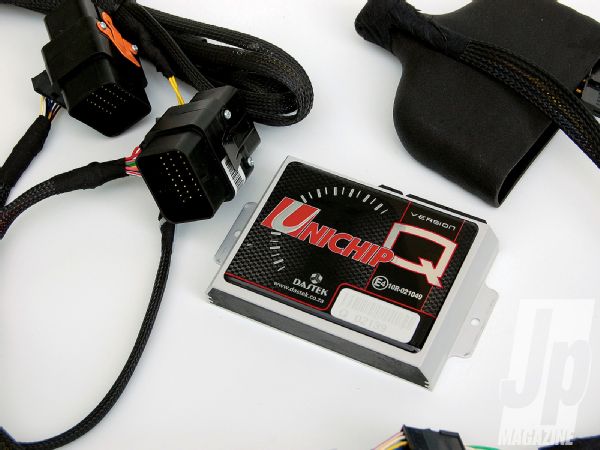
Unichip also offers an optional Flux power display. Using this you can monitor sensor data, read and clear diagnostic trouble codes, measure power, measure acceleration, have an immobilizer, and a valet mode. The Flux uses a Bluetooth wireless connection and works on your Windows-based smart phone (Windows Mobile 5 or 6).
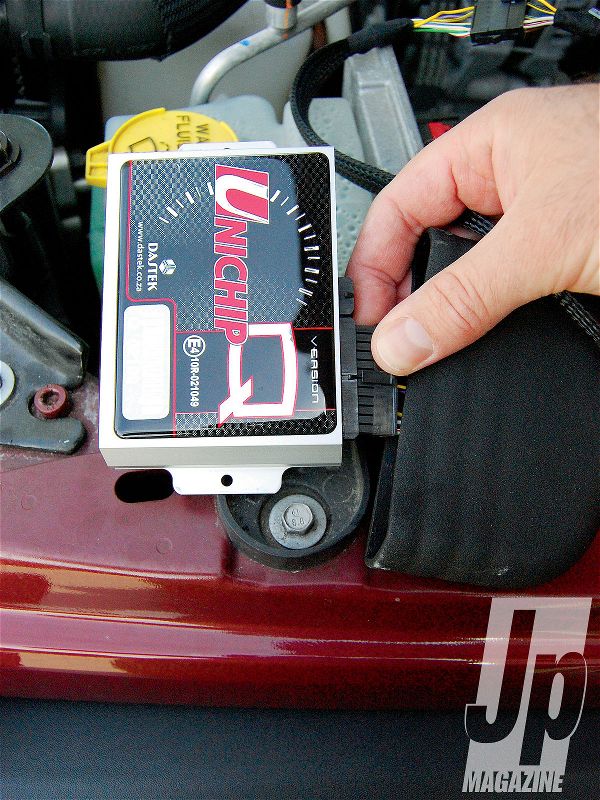 Installation of the Unichip Plug-n-Play Kit is relatively simple, taking 15 minutes the first time, and about five minutes each time after that. One of the features we liked best about the Unichip was a physical switch to go from 87- to 93-octane modes. This is quick and easy. The Unichip provided a noticeable difference around town and at wide-open throttle.
Installation of the Unichip Plug-n-Play Kit is relatively simple, taking 15 minutes the first time, and about five minutes each time after that. One of the features we liked best about the Unichip was a physical switch to go from 87- to 93-octane modes. This is quick and easy. The Unichip provided a noticeable difference around town and at wide-open throttle.
Another unique feature of the Unichip is a switch that allows this in-line module to switch quickly between calibrations for both 87- and 93-octane fuel. Unlike a programmer that will take 15-30 minutes to change from a low-octane tune to one for high-octane, the Unichip is literally a flip of the switch and it's ready to go. For both calibrations, the Unichip computer maximizes fuel and ignition timing for optimum power.
